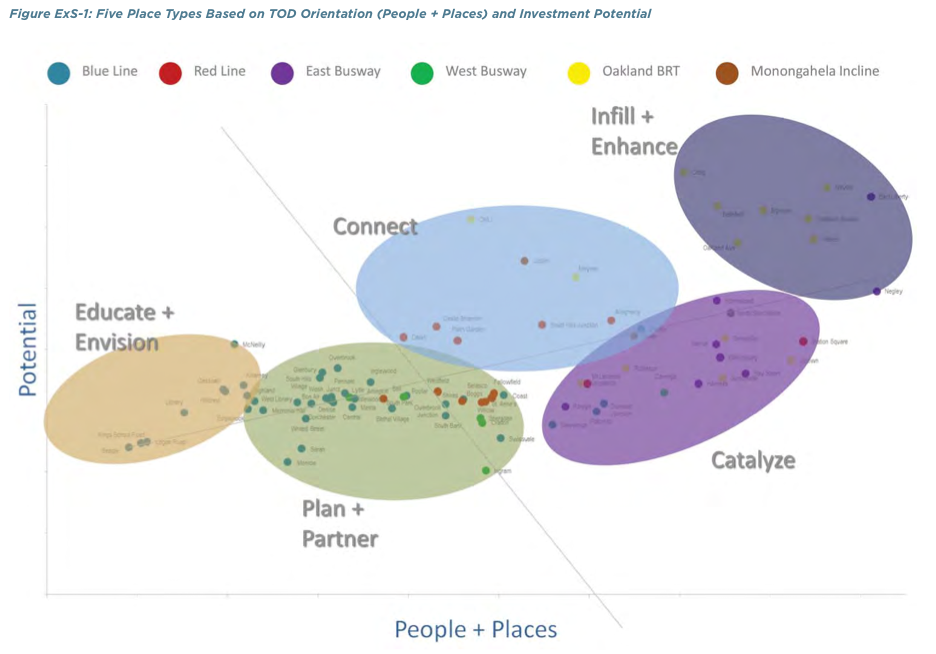CENTER FOR TRANSIT ORIENTED DEVELOPMENT
Executive Summary
Cities and regions from coast to coast are pursuing transit-oriented development (TOD) strategies as a way to achieve many goals, including increased economic competitiveness through improved quality of life, reduced congestion, lower transportation costs for households, improved air quality, reduced costs for providing city services, and growth management. The concept of TOD is becoming more popular as the number of regions planning light rail, bus rapid transit, and other fixed-guideway transit investments expands.
While other regions must spend hundreds of millions – or billions – to create transit-oriented communities, Allegheny County, fortunately, is well-poised to capture the creative labor force and new employers interested in the improved quality of life offered through transit-oriented living that its current fixed-guideway investments could catalyze. Many of the county’s neighborhoods – and surrounding communities – were built around historic transit lines. A large share of neighborhoods near the T, Busways, and Incline stations are already walkable and include their own nearby community retail and service amenities. However, a more systematic approach to transit-oriented investments is needed to unlock the potential of these neighborhoods and draw regional economic growth. This Transit-Oriented Development Typology Strategy is designed to provide a framework for understanding what these transit-oriented investments are, where they can leverage the greatest economic potential, and how they can be funded and implemented.
This Strategy focuses on the region’s fixed-guideway transit network, which includes the East, West and South Busways, the Blue Line and Red Line T, the Monongahela Incline, and the planned Downtown to Oakland Bus Rapid Transit corridor.
What is Transit-Oriented Development?
Transit-Oriented Development, or TOD, by definition is the integration of transportation with surrounding land uses. This integration is accomplished through urban design, zoning, community development, and supportive infrastructure investments and results in neighborhoods where residents and workers can get around without a car. Rather than being defined by a particular mix of uses at a particular density, successful TOD is defined by shared traits like neighborhoods that foster transportation choices of all kinds and healthy communities with vibrant commercial districts serving the daily needs of the residents.
TOD Opportunities and Constraints
Many Allegheny County neighborhoods have characteristics of TOD, but topography and other barriers often limit full access to the transit stations or between neighborhoods.
An advantage of most Allegheny County communities served by fixed-guideway transit is their physical form. Unlike many other regions, which would have to tear down or retrofit entire neighborhoods to support walkability, most neighborhoods around existing fixed-guideway stations could become significantly more transit-oriented with small- or moderate-scale, strategic access improvements.
However, many historic transit lines have been dismantled, leaving walkable communities that have become isolated from the region’s major job centers. And for many of the areas that have retained fixed-guideway transit (e.g. the Red Line corridor), topography presents an access challenge to getting to stations, especially in communities with aging populations. In the case of the East Busway, the transit infrastructure itself, which operates alongside a major freight rail corridor, presents a physical and psychological barrier.
Read full report (PDF) here: Transit-Oriented Development Typology Strategy for Allegheny County
About Center for Transit-Oriented Development
www.ctod.org
“The Center for Transit-Oriented Development (CTOD) is the only national nonprofit effort dedicated to providing best practices, research and tools to support equitable market-based transit-oriented development. CTOD partners with both the public and private market sectors to strategize about ways to encourage the development of high performing communities around transit stations and to build transit systems that maximize development potential. CTOD works to integrate local and regional planning, generate new tools for economic development, real estate and investment issues, improve affordability and livability for all members of the community, and respond to imperatives for climate change and sustainability. The Center for TOD is a partnership of Reconnecting America, the Center for Neighborhood Technology, and Strategic Economics.”
Tags: Allegheny County, Center for Transit Oriented Development, COTD, PA, Pittsburgh, Typology Strategy







 RSS Feed
RSS Feed